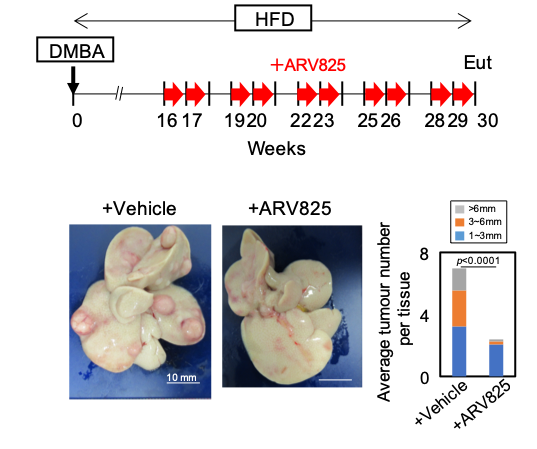A BET family protein degrader provokes senolysis by targeting NHEJ and autophagy in senescent cells (Hara Lab, in Nat Commun)
Although cellular senescence acts primarily as a tumour suppression mechanism, the accumulation of senescent cells in vivo eventually exerts deleterious side effects through inflammatory/tumour-promoting factor secretion. Thus, the development of new drugs that cause the specific elimination of senescent cells, termed senolysis, is anticipated. Here, by an unbiased high-throughput screening of chemical compounds and a bio-functional analysis, we identify BET family protein degrader (BETd) as a promising senolytic drug. BETd provokes senolysis through two independent but integrated pathways: (i) attenuation of non-homologous end joining (NHEJ), and (ii) up-regulation of autophagic gene expression. Notably, BETd treatment eliminates senescent hepatic stellate cells in obese mouse livers, accompanied by the reduction of liver cancer development. Furthermore, the elimination of chemotherapy-induced senescent cells by BETd substantially increases the efficacy of chemotherapy against xenograft tumours in immunocompromised mice. These results reveal the vulnerability of senescent cells and open up the possibilities for its control.
This article was published in Nature Communications, on April XX, 2020.
Title: A BET family protein degrader provokes senolysis by targeting NHEJ and autophagy in senescent cells
Authors: Masahiro Wakita, Akiko Takahashi, Osamu Sano, Tze Mun Loo, Yoshinori Imai, Megumi Narukawa, Hidehisa Iwata, Tatsuyuki Matsudaira, Shimpei Kawamoto, Naoko Ohtani, Tamotsu Yoshimori, & Eiji Hara
Links
- Home
- Achievement
- Research Activities
- A BET family protein degrader provokes senolysis by targeting NHEJ and autophagy in senescent cells (Hara Lab, in Nat Commun)









